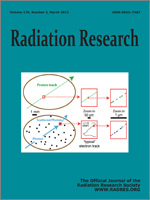The synergistic interaction of cisplatin with ionizing radiation is the clinical rationale for the treatment of several cancers including head and neck, cervical and lung cancer. The underlying molecular mechanism of the synergy has not yet been identified, although both DNA damage and repair processes are likely involved. Here, we investigate the indirect effect of γ rays on strand break formation in a supercoiled plasmid DNA (pGEM–3Zf-) covalently modified by cisplatin. The yields of single- and double-strand breaks were determined by irradiation of DNA and cisplatin/DNA samples with 60Co γ rays under four different scavenging conditions to examine the involvement of hydrated electrons and hydroxyl radicals in inducing the DNA damage. At 5 mM tris in an N2 atmosphere, the presence of an average of two cisplatins per plasmid increased the yields of single- and double-strand breaks by factors of 1.9 and 2.2, respectively, relative to the irradiated unmodified DNA samples. Given that each plasmid of 3,200 base pairs contained an average of two cisplatins, this represents an increase in radiosensitivity of 3,200-fold on a per base pair basis. When hydrated electrons were scavenged by saturating the samples with N2O, these enhancement factors decreased to 1.5 and 1.2, respectively, for single- and double-strand breaks. When hydroxyl radicals were scavenged using 200 mM tris, the respective enhancement factors were 1.2 and 1.6 for single- and double-strand breaks, respectively. Furthermore, no enhancement in DNA damage by cisplatin was observed after scavenging both hydroxyl radicals and hydrated electrons. These findings show that hydrated electrons can induce both single- and double-strand breaks in the platinated DNA, but not in unmodified DNA. In addition, cisplatin modification is clearly an extremely efficient means of increasing the formation of both single- and double-strand breaks by the hydrated electrons and hydroxyl radicals created by ionizing radiation.
How to translate text using browser tools
31 January 2013
Cisplatin Enhances the Formation of DNA Single- and Double-Strand Breaks by Hydrated Electrons and Hydroxyl Radicals
Mohammad Rezaee,
Léon Sanche,
Darel J. Hunting
ACCESS THE FULL ARTICLE

Radiation Research
Vol. 179 • No. 3
March 2013
Vol. 179 • No. 3
March 2013




